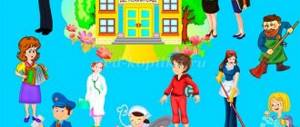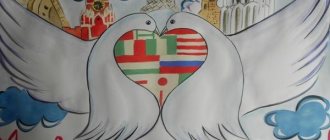Conversation: “April 12 - International Cosmonautics Day” class hour (5th grade)
Conversation: “April 12 – International Cosmonautics Day”
Goal: to develop children's knowledge about space, famous astronauts and space discoverers;
promote the activation of cognitive activity of students; developing a sense of patriotism through acquaintance with the great achievements of the Russian people.
PLAN:
-What is space?
-Space exploration.
-Profession astronaut. Equipment: - projector, computer, screen. Media accompaniment: - video film “History of the development of astronautics”
Design: - portraits of astronauts, cosmodromes, spacecraft, space travelers, planets, etc. Lesson progress.
What holiday does our entire country and countries around the world celebrate on April 12? INTERNATIONAL COSMONAUTICS DAY Today we will talk about how people began to explore outer space, and why on April 12 we celebrate Cosmonautics Day. (Slide 1) After all, it was from this day – April 12, 1961 – that man began space exploration. It seems familiar to us that spaceships launch from Earth. In the high celestial distances, spacecraft dockings take place. Cosmonauts live and work in space stations for months, and automatic stations go to other planets.
WHAT IS SPACE
Since ancient times, people began to think about the questions “What is space?” What if there is life on other planets?
What is space???? Our land and everything that surrounds it
Called the Universe or space.
Space is very large - it is a mysterious world of stars, planets and other objects. (SLIDE 2)
What planet do we live on? (slide 3)
Earth is a planet in the solar system. The solar system is a small part of the Universe. It belongs to the star system – the Galaxy. There are millions of galaxies in the Universe. Galaxies close to each other form a group of galaxies. Currently, people are exploring near space. (SLIDE 4)
1 Our SOLAR system consists of a central body, the Sun, of eight planets, one of which is our Earth. The word “planets” comes from the word “wandering”; they were named so because they constantly change their position against the background of stars. Planets of the solar system: Mercury, Venus, Earth, Mars, Jupiter, Saturn, Uranus, Neptune. Earth is the third planet farthest from the Sun. Our planet Earth moves around the Sun.
2 The Sun is the closest star to Earth. This is a huge hot cosmic body that constantly emits light and heat.
3 Mercury is the planet closest to the Sun. It is a barren rocky desert. Its entire surface is pitted with huge dents - craters. They were left by rocks called meteorites that fell on the planet.
4 Venus is the hottest planet in the solar system. It is surrounded by a thick layer of clouds, and sunlight that passes through them and is reflected from the surface of the planet cannot escape back. The temperature on the surface of Venus reaches 480* C.
5 The third planet from the Sun, which has become our home, is Earth. Our planet plays a unique role in the solar system, because Earth is the only planet that has life!
6 Mars is the fourth planet from the Sun. Mars is cold and dusty. Its crust is made of iron, which gives the planet its rusty-brown color.
7 Jupiter is the largest planet. It looks solid, but in fact it is almost entirely gas.
8 Saturn is smaller than Jupiter, but it is still a very large planet. It also consists of gas. Saturn is famous for its rings.
9 Uranus is the seventh planet from the Sun. This planet also consists mainly of gas.
10 Neptune is the smallest planet of the gas giants, but it is still 17 times larger than Earth. Hurricanes rage in its atmosphere and the strongest winds blow in the entire solar system.
Student:
| 1 In the center of the solar system is a red-hot miracle ball. This is the sun, we all know, heat comes from it | 2 And around it, rotating, Nine planets move. The fiery light of the sun illuminates their path. |
| 3 Among them, our planet dances in the sky. It's not easy to even imagine that the dance lasts a year. | 4 We, earthlings, children of the Sun, are very lucky in life. The sun gives light in the window, Joy, happiness and warmth |
SPACE EXPLORATION
People have long dreamed of taking to the air. They created many flying machines. (SLIDE 6)
Is it possible to use at least one device presented on the slide to get to the Moon or go to other planets? So what will lift us up? (SLIDE7) Rocket
Soviet scientist Konstantin Eduardovich Tsiolkovsky was one of the first to put forward the idea of using rockets for space flights. He designed a rocket for interplanetary communications in 1901. (SLIDE Unfortunately, he did not have the opportunity to build it.
He designed a rocket for interplanetary communications in 1901. (SLIDE Unfortunately, he did not have the opportunity to build it.
The brilliant successor of his work is Sergei Pavlovich Korolev. Under his leadership, ballistic and geophysical rockets, the first artificial Earth satellites, and the first spaceships were created, which for the first time in history carried out a human space flight and a human spacewalk. (SLIDE 9)
Korolev, together with other scientists, created rockets in which people could fly into space. But first, two small dogs went into space - Belka and Strelka (SLIDE 10)
Scientists wanted to determine how a living organism survives space flight.
In space, any living creature becomes weightless. Neither animal nor man can walk normally. It's like they're flying.
Let's see an experiment that will show what weightlessness is.
“Floating egg” (a transparent glass of water or a jar, a few tablespoons of salt. Put the egg in a glass of clean water, it has fallen to the bottom. Take out the egg and dissolve the salt in the water. Lower the egg again and it floats on the surface. Then add a little clean water so that the egg is in the middle.) Our egg has a state of weightlessness like people in space.
Using dogs, scientists wanted to test how weightlessness affects a living organism. Belka and Strelka survived this flight. Now it was time to send a man into space.
On April 12, 1961, Yuri Alekseevich Gagarin made the first flight into space in the history of mankind on the Vostok spaceship. (SLIDE 11) The spaceship, together with Gagarin, flew around the Earth once in 1 hour 48 minutes. People all over the world watched this flight with bated breath. It was the most outstanding event of the 20th century. Man made his first flight into space. And it was a Soviet man - Yuri Alekseevich Gagarin.
| 1: Both boys and girls, In reality and in good dreams Everyone dreams of space About distant skies. | 2: Today is a holiday for astronauts! Congratulations on this day. Gagarin discovered it for us Much has been said about him. |
| 3: He is the first cosmonaut in the world, That's why he's a hero to everyone. He was the kindest person He had an unearthly smile. | 4: That’s why this holiday Became good for the kids. Because, apparently, it’s about space Everyone in childhood thought |
| 5: Looks like Gagarin All boys want to be. Children draw in honor of him Multi-colored starfall. | 6: In honor of Gagarin - avenues, Ships and boats... Today is the holiday of astronauts: Cosmonautics - Hurray! |
Tereshkova made the world's first flight of a female cosmonaut on June 16, 1963 on the Vostok-6 spacecraft; it lasted almost three days. Tereshkova was awarded the title “The Greatest Woman of the 20th Century.”
The first human spacewalk was performed by Soviet cosmonaut Alexei Arkhipovich Leonov. He was the first to go into outer space, about which no one knew anything. (SLIDE 12)
Nowadays, going into outer space for astronauts is difficult, but quite familiar work. They go into outer space for research, to repair the ship, to install new equipment. But humanity strives further, beyond the solar system. People dream of intergalactic spaceships, and perhaps someday we will meet representatives of extraterrestrial civilizations. (SLIDE 13)
Profession astronaut
He is not a pilot, not a pilot. He is not piloting a plane, but a huge rocket. Children, who can tell me what this is? (astronaut) (SLIDE 14)
What should it be like?
Smart, healthy, strong, resourceful, kind, brave, determined, hardworking.
“Orbital station”: 1 An astronaut in space has a space home called an orbital station. The orbital station looks like a huge bird that has spread its wings and flies above the earth. The rocket brings the astronauts to the station, and itself flies away and burns up in space. Nowadays, not one person flies into space, but a whole team of three or four astronauts, and these can be astronauts from different countries. (SLIDE 15)
2 “Cosmonaut clothes” For work, the astronaut leaves the orbital station into outer space. In outer space it is dangerous for human health - there is no air, so astronauts wear special protective clothing - a spacesuit (SLIDE 16)
3 “Work at the orbital station” cosmonauts at the orbital station are engaged in research activities: they study the stars, the surface of our earth, check the weather, photograph the Earth. (SLIDE 17)
4 “Astronaut's Dream” Sleep according to the schedule takes 8 hours, but in practice many people rest for only 4-5 hours, and that’s enough for them. You have to sleep in sleep masks and with earplugs (these are special earplugs) so that the noise of numerous mechanisms does not interfere.
Astronauts sleep in special sleeping bags, fastened with belts. And if you don’t fasten them, then due to the state of weightlessness they will fly. (SLIDE 18)
5 "Space food"
The astronauts do not cook their own food; the food is delivered to them by a cargo spacecraft. The food is pureed and placed in tubes, like toothpaste. When astronauts eat, they squeeze food directly into their mouths; what kind of food can be in these tubes. (SLIDE 19)
6 "Return to Earth"
Astronauts can stay in space for a very long time, from several months to a year.
How can the astronauts return after their rocket burned up in space?
The astronauts return home in a special capsule with a parachute. On Earth, the astronauts are met by doctors who check their health, military personnel, friends and journalists who interview them. (SLIDE 20)
| We congratulate our dear cosmonauts today, and we sincerely wish you to fly to Mars! | May you have great starry paths and earthly moods, May your flights bring you unearthly inspiration! | But we wish you love completely earthly From the bottom of our hearts, In this wonderful congratulation, we praise the astronauts! |
Answer the questions.
What planets of our solar system do you know? (Mercury, Venus, Earth, Mars, Jupiter, Saturn, Uranus, Neptune)
Which of the scientists in our country is the founder of astronautics? (K.E. Tsiolkovsky)
Name an outstanding designer of rocket and space systems, whose name is associated with our country’s first victories in space exploration. (Academician S.P. Korolev)
Name the astronaut who made the first space flight. (Yu.A. Gagarin)
What event is the celebration of Cosmonautics Day dedicated to? (On April 12, 1961, Yu.A. Gagarin made the first space flight) (SLIDE 20)
Conclusion. So why is the Cosmonautics Day holiday so important for Russia (slide 21)
April 12 is Cosmonautics Day. This day is significant because it was the first manned flight into space. The world's first cosmonaut is our compatriot, hero of the Soviet Union, Yuri Gagarin. The study of space is very important for all humanity, because important research is carried out at stations in orbit that can only be carried out in space. Also, stations in the orbit of our planet are used to predict weather and for military purposes. Also, do not forget that 99% of space has not yet been explored, which means that perhaps interesting and great discoveries await us ahead.





